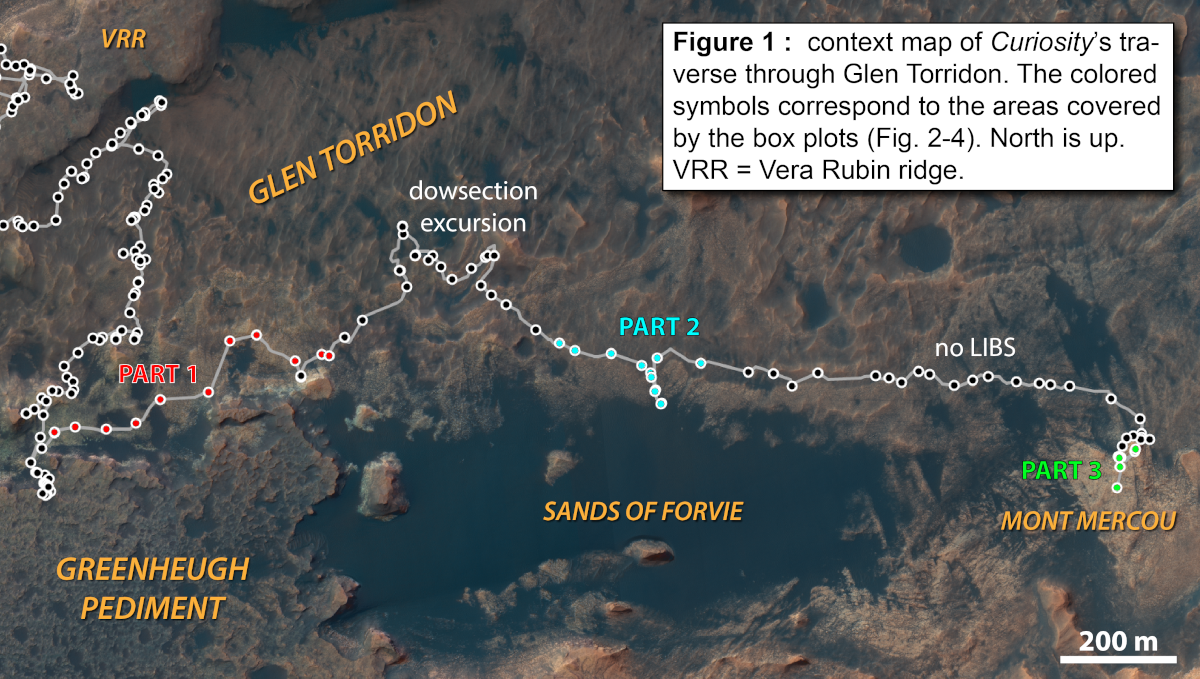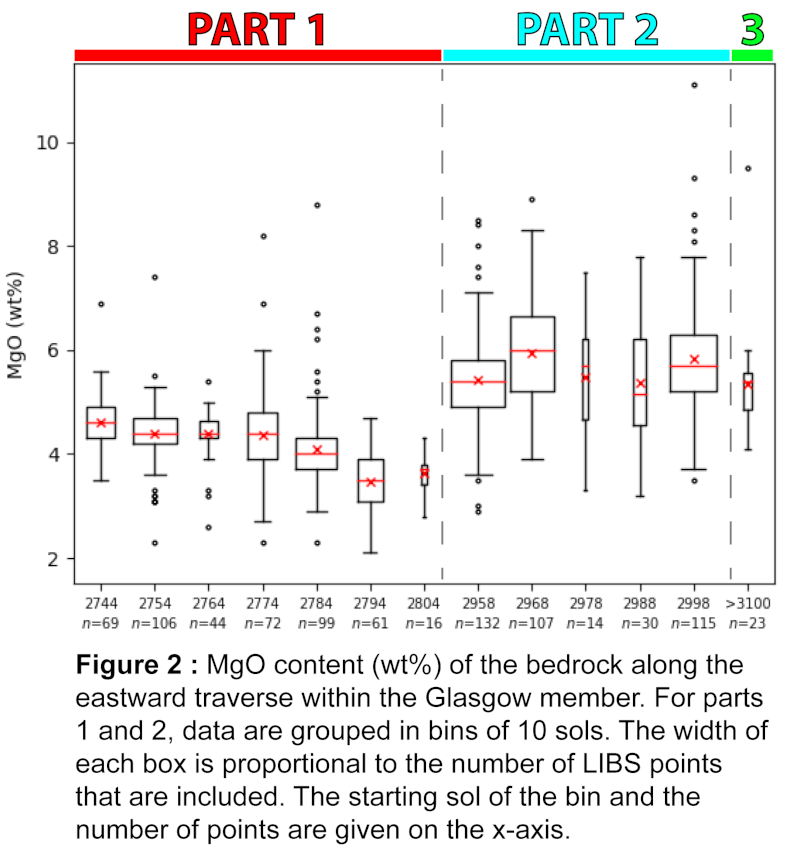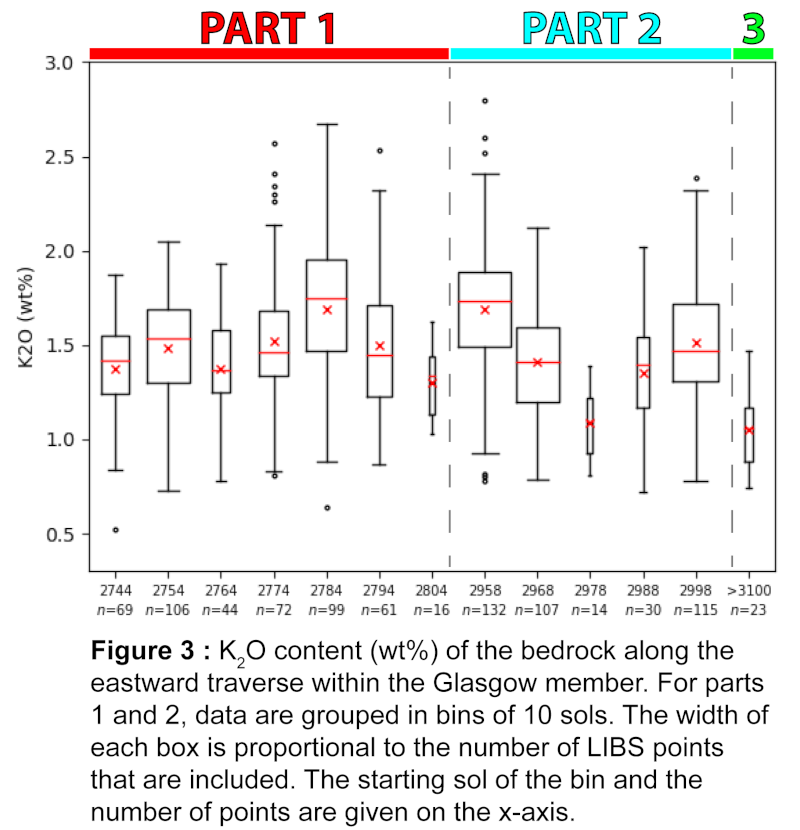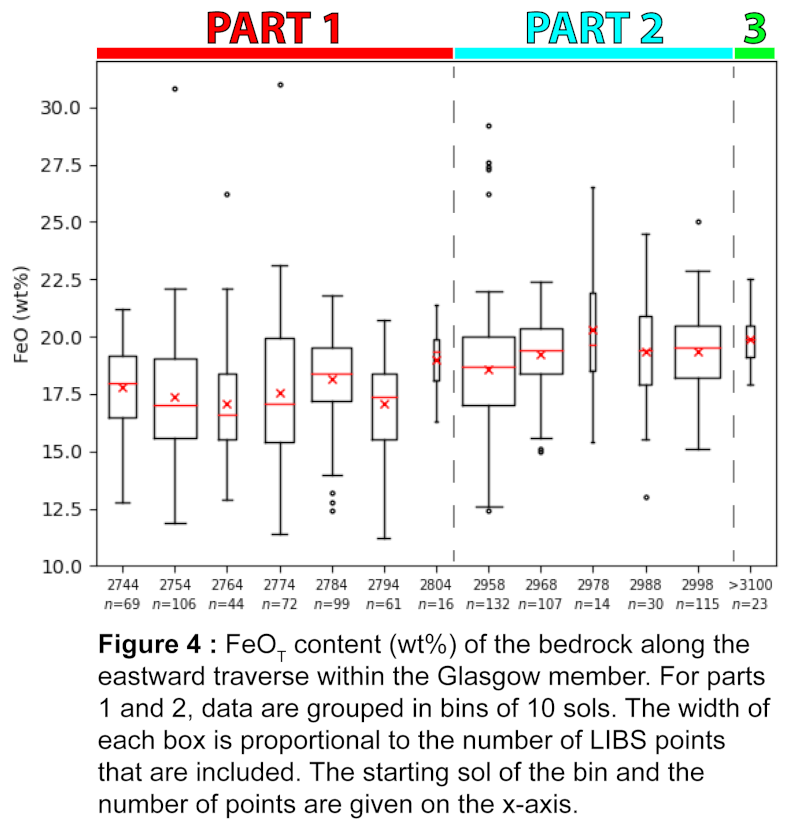- 1LGL-TPE, Lyon, France (erwin.dehouck@univ-lyon1.fr)
- 2IRAP, Toulouse, France
- 3LPG, Nantes, France
- 4University of Copenhagen, Denmark
- 5LANL, New Mexico, USA
- 6Lunar and Planetary Institute, USRA, USA
- 7University of Minnesota, USA
- 8USGS Astrogeology, Arizona, USA
- 9University of California, Berkeley, USA
Introduction
In January 2019, the Mars Science Laboratory (MSL) rover Curiosity started exploring the Glen Torridon (GT) region of Gale crater, which corresponds to the topographic trough between the Vera Rubin ridge and the Greenheugh pediment (Fig. 1). From orbit, this region stands out due to the relatively strong near-infrared signatures of clay minerals [1,2]. The in-situ data collected so far by Curiosity have allowed the MSL team to confirm and quantify the presence of these clay minerals [3], to characterize their organic content [4], and to document in detail their geochemical and sedimentological settings [5].
In particular, the bedrock chemistry measured by ChemCam shows elevated values of the Chemical Index of Alteration (CIA) throughout most of Glen Torridon [6,7], which indicates an open-system type of alteration [8]. In addition, the ChemCam observations suggest the presence of illite in the fine-grained rocks [9] and reveal a possible relationship between grain size and geochemical variations [10]. Finally, they show that the light-toned rocks located just below the unconformity at the base of the Greenheugh pediment (Fig. 1) are associated with “anomalous” bedrock compositions that may be related to a late-stage diagenetic event at Gale [7].
Here, we report the findings of the ChemCam instrument along a ~2-km eastward traverse within the upper member – named Glasgow – of the Glen Torridon region (Fig. 1). This traverse allowed Curiosity to investigate the lateral variability of this member, while also getting gradually closer to the transition into the overlying sulfate-bearing unit [11].

Dataset
ChemCam measures the chemical composition of targeted rocks and soils within a few meters of the rover using laser-induced breakdown spectroscopy (LIBS). Quantification of eight major rock-forming oxides is performed routinely [12]. Each ChemCam analysis consists of a raster of several points a few millimeters apart from each other, and each point itself consists of a series of laser shots (typically 30). For bedrock targets, this approach allows removal of unwanted contributions from Ca-sulfate veins or soil material by discarding the corresponding points [e.g., 8].
On sol 3007, ChemCam experienced a technical issue, which required halting the use of the laser during the time of the investigation, while imaging and passive spectroscopy activities continued. LIBS analyses on Mars targets resumed on sol 3107, in the Mont Mercou area (Fig. 1), ~600 m to the east and ~19 m higher in elevation. In addition, data acquired between sols 2816 and 2956 are not used here, since they correspond to a downsection excursion into the underlying Knockfarril Hill member [13].
Results
Variations in MgO, K2O and FeOT abundances along the rover path within the Glasgow member are shown in Figures 2, 3 and 4 (respectively). The bedrock composition is overall homogeneous, although small variations are observed for some oxides. In particular, the mean MgO abundance was well below 5 wt% in the western part of the traverse, but reached nearly 6 wt% after the downsection excursion (Fig. 2). This increase in MgO is accompanied by slightly lower Al2O3 abundances (not shown here).
In contrast, the K2O content does not show a clear change after the excursion (Fig. 3); however, it decreases slightly during the exploration of an area with rougher terrain (previously mapped as “fIU rubbly” [14]), between sols 2973 and 3000.
Regarding FeOT, large variations have been observed at small scale (i.e., within a given LIBS raster) in a group of targets characterized by the presence of dark nodules, likely of diagenetic origin [15,16]. These nodules have high FeOT (up to ~50 wt%), whereas the points in between the nodules show low FeOT (down to ~12.5 wt%). However, at the scale of the whole Glasgow member, the mean FeOT content is quite stable, with only a subtle increase in the eastern part of the traverse (Fig. 4).
As mentioned above, the most recent data (last bin in Fig. 2-4) were acquired after a gap of ~600 m laterally and ~19 m vertically. Despite this gap, the bedrock compositions appear remarkably similar to those measured earlier in the Glasgow member, especially after the downsection excursion. This suggests that no major change of environment occurred during the time when LIBS was unavailable.



Discussion and conclusion
Curiosity’s eastward traverse within the Glasgow member is a rare opportunity to investigate the lateral variability of Gale sedimentary strata at the kilometer scale. The compositions appear overall homogeneous, but some variations are observed. As previously seen in Glen Torridon [6,7,10], Mg and K are the two most varying elements; however, their variations are not always well correlated, as illustrated by the trends observed after the downsection excursion (Fig. 2-3). In addition, while FeOT displays significant variations within some LIBS rasters due to the presence of dark nodules in the bedrock, it is stable at the scale of the whole Glasgow member, which suggests that diagenetic remobilization of iron occurred at small scale only.
Finally, the latest data acquired in the Mont Mercou area show that the bedrock compositions are still remarkably similar to those measured ~2 km to the west, when Curiosity first encountered the Glasgow member. As the rover continues to progress uphill, ChemCam will continue surveying the bedrock in search of the first chemical indications of the clay-to-sulfate transition.
References: [1] Milliken et al. (2010) GRL, 37. [2] Fraeman et al. (2016) JGR-Planets, 121. [3] Thorpe et al. (2021) LPSC, abstract #1519. [4] Millan et al. (2021) LPSC, abstract #2039. [5] Fedo et al. (2020) LPSC, abstract #2345. [6] Dehouck et al. (2020) LPSC, abstract #2770. [7] Dehouck et al. (2020) AGU Fall Meeting, abstract #P070-06. [8] Mangold et al. (2019) Icarus, 321. [9] Cousin et al. (2021) LPSC, abstract #2127. [10] Caravaca et al. (2021) LPSC, abstract #1455. [11] Rapin et al. (2021) Geology, 49. [12] Clegg et al. (2017) Spectrochim. Acta B, 129. [13] Dehouck et al. (2021) LPSC, abstract #1858. [14] Hughes et al. (2021) LPSC, abstract #1586. [15] David et al. (2021) LPSC, abstract #1433. [16] Gasda et al. (2021) LPSC, abstract #1271.
How to cite: Dehouck, E., Cousin, A., Mangold, N., Frydenvang, J., Gasnault, O., Rammelkamp, K., Rapin, W., Forni, O., Gasda, P. J., David, G., Caravaca, G., Lasue, J., Meslin, P.-Y., Bedford, C. C., Lanza, N. L., Fox, V. K., Bennett, K. A., Bryk, A. B., Maurice, S., and Wiens, R. C.: Bedrock geochemistry measured by ChemCam along a 2-km eastward traverse in the Glen Torridon region, Gale crater, Mars, Europlanet Science Congress 2021, online, 13–24 Sep 2021, EPSC2021-595, https://doi.org/10.5194/epsc2021-595, 2021.

